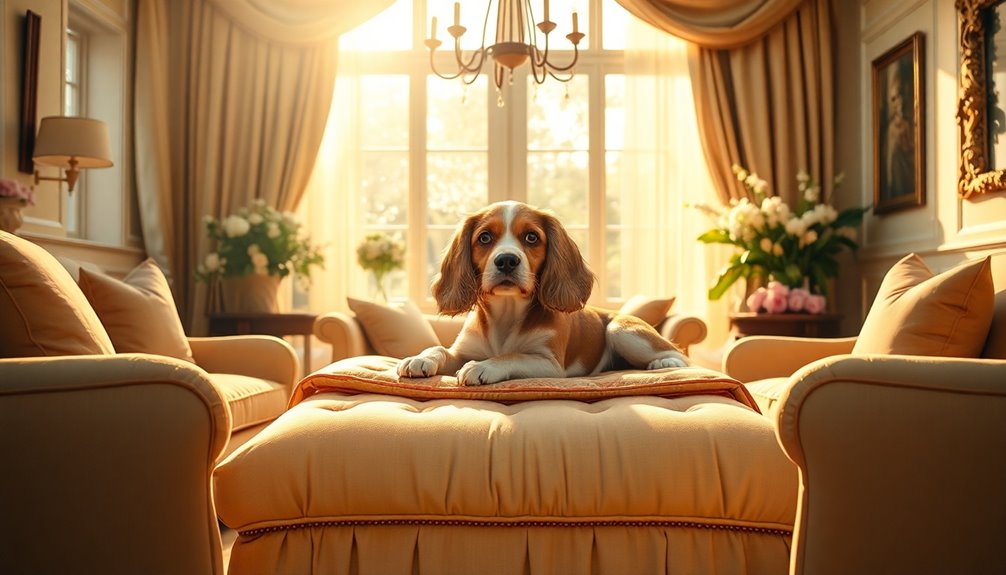The English Toy Spaniel is a delightful royal lapdog you'll undoubtedly adore. With its charming appearance and gentle nature, this breed captures hearts effortlessly. Originating from England, it enjoyed a pampered life among royalty, including King Charles II. These compact dogs, averaging 9 to 11 inches tall, boast long furry ears and large, expressive eyes. They thrive on affection and can be excellent companions for families or individuals in calm environments. Regular grooming helps keep their silky coat healthy, and early socialization is key for a well-rounded pet. Curious about how to care for your future furry friend?
Key Takeaways
- The English Toy Spaniel, with its charming appearance and gentle demeanor, makes an ideal companion for lapdog lovers.
- This breed has royal connections, favored by figures such as King Charles II and Queen Mary I, adding to its allure.
- Their affectionate nature and playful disposition make them excellent pets for families, seniors, and individuals seeking companionship.
- Regular grooming is essential to maintain their silky double coat and prevent matting, ensuring they look their best.
- With proper care and socialization, English Toy Spaniels exhibit loyalty and thrive in loving environments, making them truly adored companions.
Introduction

The English Toy Spaniel has captured hearts since its origins in England, known for its charming appearance and gentle demeanor. With large, dark, expressive eyes and long, furry ears, this small breed is hard to resist. Its domed skull and compact size give it a distinctive look that many find endearing. You'll appreciate the variety in its coat, which comes in four stunning varieties, adding to its appeal.
Beyond its looks, the English Toy Spaniel has a delightful temperament. This breed is affectionate and playful, forming strong bonds with family members, while being a bit reserved around strangers. You might find their stubborn streak complicates training, but their merry, bright nature more than makes up for it. Loyal and quiet, they adapt well to family life. Their moderate energy level means they require at least an hour of exercise daily to stay happy and healthy.
Perfect for families, they're kid-friendly and get along well with other pets, though their hunting instinct means they're not suited for small animals like birds.
Due to their small size and calm demeanor, they make excellent travel companions. With proper care, including grooming and regular maintenance, this charming breed can bring joy and companionship to your home.
History and Origin

You might be surprised to learn that the English Toy Spaniel has roots in East Asia, with its ancestors likely arriving in Europe during the 16th century.
This charming breed quickly became a beloved companion among English royalty, particularly during the reign of King Charles II. The breed gained immense popularity due to the royal proclamation that allowed Toy Spaniels entry in all British Empire venues.
Their royal connections helped shape their development and popularity, making them a true symbol of nobility.
Where and when the breed originated
Originating from a blend of influences across various regions, the English Toy Spaniel's history is shrouded in mystery. Speculation about its origins points to ancient civilizations in the East, particularly China and Japan, while other theories suggest a lineage that began in Spain before developing in Asia.
Despite the various theories, the true roots of the breed remain unclear, as early written references don't provide definitive answers.
The first documented mention of the English Toy Spaniel in England dates back to 1570. However, the breed truly flourished during the reigns of King Charles I and II from 1625 to 1685, when it became a favorite among the nobility. Additionally, this breed was cherished for its companionship rather than work, highlighting its role as a loyal lapdog throughout history.
Its popularity in Britain dates back to Tudor times and continued to grow, especially within royal courts. Cross-breeding with Asian breeds like the Pug and Japanese Chin contributed to the English Toy Spaniel's distinct appearance.
Additionally, it gained attention in France during its peak popularity. The American Kennel Club recognized the breed in 1886, marking a significant milestone in its history, yet the intricate tapestry of its origins remains tantalizingly elusive.
Royal Companion for Nobility
Throughout history, English Toy Spaniels have nestled into the hearts of nobility, earning their place as cherished royal companions. Their journey began during Queen Mary I's rule, but it was King Charles II who truly elevated their status. Known for his affection for these spaniels, he allowed them in public spaces, including the House of Parliament, and even issued a decree granting them free access to any court or palace in England. This royal favor significantly boosted their popularity in the 17th century.
These loyal dogs were often seen by the sides of kings and queens, accompanying King Charles I to his execution and reportedly grieving over Mary, Queen of Scots' death. Such unwavering loyalty made them beloved companions, frequently depicted in art and literature. With their moderate energy levels, they were also well-suited to the leisurely lifestyle of the aristocracy, making them perfect lap companions for those seeking comfort.
The breed's charm continued through the ages, with Queen Victoria and her great-granddaughter Grand Duchess Anastasia also embracing them. Their unique privileges, like roaming freely in Whitehall Palace during state occasions, reflected their esteemed position.
English Toy Spaniels weren't just pets; they were symbols of loyalty and devotion, cherished by those in power and adored by all who met them.
Physical Characteristics

When you look at the English Toy Spaniel, you'll notice its compact, sturdy build, standing just 9 to 11 inches tall and weighing between 8 to 14 pounds.
Its double coat is medium-length and silky, featuring heavy fringing on the ears and body that adds to its charm.
With regular grooming, you can maintain those beautiful feathered fringes that make this breed truly stand out. Additionally, their distinctive appearance includes a round head and short muzzle, which further enhances their overall elegance.
Size, weight, and coat details
Understanding the physical characteristics of the English Toy Spaniel reveals a charming little breed that's perfectly suited for companionship. Standing between 9 to 13 inches at the withers, these dogs are compact and easily fit in your lap. With a body length of 15 to 19 inches and a tail that's about 4 inches long, they boast a delightful, proportional figure.
Weighing between 8 to 14 pounds, they comfortably nestle beside you, making them ideal lap dogs.
Their coat is one of their most appealing features, with four recognized color combinations: Blenheim (red and white), King Charles (black and tan), Prince Charles (white, black, and tan), and Ruby (solid red). The coat is medium-length, slightly wavy or straight, and feels thick and silky to the touch. The English Toy Spaniel typically has a lifespan of 10-14 years, making them a long-term companion for families.
It's essential to maintain their stunning double coat with regular grooming, ideally combing them twice a week. This not only keeps them looking their best but also ensures their skin stays healthy.
The English Toy Spaniel's size and beautiful coat make them not just adorable companions, but also a joy to care for.
Feathered, Silky Ear Fringes
The English Toy Spaniel's ears are one of their most striking features, captivating anyone who meets them. These long, elegant ears hang close to the head and frame the face beautifully, enhancing the breed's refined appearance. The heavy feathering on the ears is a distinctive trait that sets them apart, contributing significantly to their royal demeanor. Ideally, you won't see much white on the ears, as it's important for maintaining their classic look.
The feathered fringes extend not just to the ears but also to the legs and chest, providing a cohesive, silky coat that adds to their charm. To keep these stunning features looking their best, regular grooming is essential. You'll need to pay special attention to the ears to prevent matting and tangling, especially with seasonal shedding. Given their historical significance, these dogs were once favored by royalty in England.
When viewed from the front, the alignment of the ears should be in line with the nose, emphasizing the breed's domed skull. This careful placement complements the short muzzle and pushed-back nose perfectly.
With consistent grooming, the English Toy Spaniel's feathered ears can remain a highlight of their elegant appearance.
Temperament and Personality

The English Toy Spaniel is known for its playful yet gentle demeanor, making it a wonderful companion for families and individuals alike. You'll find that they get along well with other pets, creating a harmonious household. Their affectionate nature ensures they thrive in environments filled with love and attention. Additionally, their gentle, loving nature makes them particularly suited for being a lap dog.
Playful yet Gentle Demeanor
With their playful spirit and gentle nature, English Toy Spaniels make delightful companions for families and individuals alike. You'll find their playful side shines brightest during interactive activities like walks, visits to the dog park, or short hikes.
While they can be lively outdoors, don't worry; they're perfectly content and calm when inside, especially when it comes to cuddling on your lap. Their gentle demeanor is truly heartwarming. These dogs are known for their loving disposition and docile temperament, making them excellent lap dogs. They thrive on gentle interactions and can be sensitive to rough handling, so a soft touch is best.
English Toy Spaniels are incredibly affectionate, often following you around the house to seek companionship. They love to express their devotion through cuddles and licks. Given their small size, they are ideal for apartment living, allowing them to adapt easily to various environments.
Despite their playful antics, they don't require extensive outdoor activity, making them adaptable to various living situations. Their playful nature emerges particularly around children, creating joyful moments filled with laughter.
With their blend of playfulness and gentleness, you're sure to adore every moment spent with an English Toy Spaniel.
Suitability for families, individuals, or other pets
For families seeking a loving companion, English Toy Spaniels often prove to be an excellent choice. They're generally good with children, but you'll need to ensure gentle interactions to avoid any accidental injuries. These dogs thrive in quieter environments, so if you have very young or loud children, it might be a challenge. Early socialization is key to helping them bond with all family members and is beneficial for their gentle temperament. Additionally, creating designated zones for play can help manage interactions and ensure safety for both kids and the dog, promoting better organization in the home.
For individuals, especially seniors, these dogs are ideal due to their calm and gentle nature. They don't require extensive exercise, making them perfect for apartment living or low-key lifestyles. Their eagerness to please and ease of training also make them great companions for single owners. However, be mindful of their tendency to experience separation anxiety if left alone for too long. Regularly assessing their needs and providing mental stimulation can help mitigate this issue, allowing for a more harmonious living environment.
When it comes to other pets, English Toy Spaniels generally get along well, provided they're socialized early. They can live harmoniously with larger breeds and cats, but keep smaller animals away, as they might see them as prey. With consistent socialization, they'll adapt well to other dogs and pets in your home. Utilizing vertical storage solutions to keep pet supplies organized can also help reduce clutter and create a peaceful atmosphere for all pets involved.
Health and Lifespan

When it comes to the health and lifespan of your English Toy Spaniel, you should expect an average lifespan of 10 to 12 years.
This breed is prone to certain health issues, so being aware of common concerns can help you provide better care. Additionally, they are sensitive to anesthesia, so extra caution is advised during any medical procedures.
To keep your pup thriving, regular vet visits and a balanced diet are essential for maintaining their overall wellness.
Typical lifespan of the breed
Although the English Toy Spaniel typically enjoys a lifespan of 10 to 12 years, several factors can influence how long your furry friend stays by your side. This breed's lifespan is slightly shorter than some similarly sized breeds, so it's vital to focus on their overall health and well-being. Additionally, it is important to be aware of the risk of degenerative myelopathy due to the SOD1 gene mutation, which can affect their quality of life.
Diet plays a significant role in longevity. Be careful not to overfeed, as obesity can severely shorten their life. Regular exercise is essential; a balanced activity routine helps keep them fit and healthy.
Additionally, early detection of health issues through regular veterinary check-ups is crucial. For puppies, aim for monthly visits, while adult dogs should be seen yearly, and seniors every six months.
Genetics can also affect lifespan, as some health issues may be inherited. Environmental factors, like climate and living conditions, can impact their health too.
To maintain a long, happy life for your English Toy Spaniel, focus on a healthy diet, exercise, preventative care, and regular grooming. By being proactive about their care, you can help ensure your loyal companion remains by your side for many years to come.
Common health concerns or genetic predispositions
As you care for your English Toy Spaniel, being aware of their common health concerns and genetic predispositions can make a significant difference in their quality of life.
Heart conditions, such as heart murmurs and mitral valve disease, are prevalent in this breed, especially as they age. Regular veterinary check-ups are essential for early detection and management of these issues.
Your pup may also face eye problems like cataracts and glaucoma. Keep an eye out for symptoms such as excessive blinking, redness, or discharge. Early treatment can greatly improve their comfort and well-being.
Joint and musculoskeletal issues, including patellar luxation, may arise as your dog grows older. Maintaining a healthy weight and providing regular exercise can help mitigate these concerns. Additionally, it is important to support their active lifestyle with appropriate exercise routines to promote overall joint health.
Additionally, be on the lookout for genetic conditions like degenerative myelopathy, diabetes, and epilepsy, which can affect their overall health.
Dental problems, such as early tooth loss, are also significant. Staying informed and proactive about these common health issues will ensure your English Toy Spaniel enjoys a happy and healthy life.
Tips for maintaining health and wellness
Maintaining your English Toy Spaniel's health and wellness hinges on a balanced approach to diet, exercise, grooming, and mental stimulation.
Start with their diet; ensure you provide a balanced mix of protein, carbohydrates, fats, vitamins, and minerals. Choose high-quality dog food with meat as the first ingredient, and avoid fillers like corn, wheat, and soy. Control portions to prevent obesity, and consider high-moisture foods to keep your pup hydrated. An important consideration is that the breed typically has a moderate shedding level, which can affect your choice of grooming tools and frequency.
For exercise, short daily walks of 20-30 minutes will suffice, complemented by indoor play with toys or interaction with children. Be mindful of the weather, as these dogs don't tolerate heat well and need regular potty breaks.
Grooming is crucial, too. Brush their silky coat at least twice a week, and tackle tangles daily. Bathe them about once a month and trim their hair if it interferes with mobility or vision.
Finally, keep your pup mentally stimulated with short, positive reinforcement training sessions, engaging toys, and social interaction.
Always consult a veterinarian if you notice any changes in behavior or signs of illness. This well-rounded care will help your English Toy Spaniel thrive.
Care Requirements

Caring for your English Toy Spaniel involves regular brushing to keep their silky coat from matting. The use of an undercoat rake is recommended to gently remove dead hair and maintain a healthy coat. You'll also need to ensure they get enough exercise to match their moderate energy levels, while keeping an eye on their diet for optimal health. Additionally, routine health checks can help identify any potential issues early on. Following these guidelines will help you maintain your pup's well-being and happiness.
Regular Brushing Required
How often should you brush your English Toy Spaniel? You should brush your dog at least twice a week to remove loose fur and prevent tangles and mats. For optimal coat maintenance, aim to brush every other day. If possible, daily brushing is ideal, especially since they love to sit in your lap.
Use a soft-bristle brush to gently brush the coat, and a detangling comb for areas like the ears and chest. A soft slicker brush can also help prevent tangles. Regular brushing not only maintains their silky, medium-length coat but also reduces shedding and keeps your home cleaner. Bathing your spaniel once a month aids in reducing shedding, too.
Don't forget to trim the hair around the feet, ears, and neck monthly. Cleaning their ears and drying them thoroughly after baths is essential to prevent infections. Additionally, you should trim their nails once a month and brush their teeth daily with canine toothpaste for dental health. If you find grooming overwhelming, consider hiring a professional groomer to assist with monthly grooming needs.
Regular grooming helps maintain your spaniel's overall health and appearance, and it is particularly important due to their susceptibility to dental issues.
Exercise requirements and energy levels
Exercising your English Toy Spaniel regularly is crucial for their health and well-being. Aim for daily walks of 20-30 minutes, keeping the pace moderate to protect their joints. While they don't have high energy levels, they still need consistent physical activity to stay fit. You can mix in some playtime with fetch or light jogging if your dog can keep up.
Indoor play with toys is a great way to help them expend energy, especially during hot weather when short walks are advisable.
These little lapdogs enjoy lounging around, making them perfect for owners who prefer a less active companion. Although they love spending time outdoors, they don't require extensive outdoor activities. A fenced yard where they can play with family is ideal. Additionally, their low energy means that they are quite content to relax on the couch between activities.
Don't forget that daily potty breaks are essential alongside regular walks.
Keep in mind that English Toy Spaniels are brachycephalic, so be cautious in hot or humid conditions, allowing for breaks and monitoring their breathing.
Due to common joint issues, avoid strenuous exercise and consult your vet to tailor an appropriate exercise regimen for your furry friend.
Feeding tips and diet recommendations
When it comes to feeding your English Toy Spaniel, prioritizing high-quality dog food is essential for their health and vitality. Look for food that balances protein, carbohydrates, fats, vitamins, and minerals to support their moderate energy levels and maintain a shiny coat.
Choose protein sources like beef, chicken, turkey, and fish, and ensure the diet includes essential fatty acids and omegas for optimal health. Spot & Tango recipes are an excellent choice as they include high-quality proteins specifically tailored for aging dogs.
Feed your adult Spaniel twice a day, using measured portions to prevent overeating. Puppies will need more frequent feedings tailored to their growth needs. Always consult your vet to develop the best feeding regimen based on age and weight.
Portion control is crucial to combat obesity, a common issue in this breed.
Opt for small-breed dog food designed for their high metabolism and specific nutrient requirements. Raw food diets can also be beneficial, mimicking their natural diet. Avoid high-carb foods, as dogs struggle to digest them. Whole grains, fruits, and veggies can be included in moderation.
Treats should be given sparingly. Use high-quality, low-fat options, and ensure they don't replace their main diet but act as supplements.
Training and Socialization

When training your English Toy Spaniel, you'll find they're moderately responsive to commands, but consistency is key. Gradual introductions to new environments help them adapt and reduce any anxiety they might feel, especially during training sessions. Be mindful of their tendency toward separation anxiety, as it can affect their learning process. Utilizing crate training can also help them feel secure and promote positive behavior when left alone.
Moderately Responsive to Commands
Training your English Toy Spaniel can be a rewarding experience, as these dogs are generally responsive to commands when approached with patience and consistency. They learn quickly through consistent training activities, especially when you use positive reinforcement. Praise and small food treats work wonders in encouraging desired behaviors, so find the right reward that keeps your pup motivated. Additionally, incorporating educational toys can enhance their learning experience and keep them engaged.
Remember, some Spaniels can be picky eaters, so a bit of experimentation might be necessary. To keep training sessions enjoyable, keep them light-hearted and fun. Short, regular sessions prevent boredom and maintain your dog's engagement. Since these dogs are eager to please, they respond well to your encouragement, but be mindful to avoid negative techniques; they can be sensitive and may shut down if training feels too harsh.
Additionally, early socialization is key to developing a well-adjusted adult dog. Introduce your Spaniel to various people and pets to build their confidence and sociability. It's important to note that the English Toy Spaniel has a tendency to be prone to shyness, which makes socialization all the more essential.
With your commitment to consistent training and positive experiences, you'll foster a happy, responsive English Toy Spaniel who thrives in various situations.
Gradual Introductions to New Environments
Introducing your English Toy Spaniel to new environments should be a gradual process that fosters confidence and comfort.
Start by designating a puppy-proofed area in your home, introducing them to one room at a time while skipping off-limits areas. Ensure they've a safe space, like their crate or dog bed, and supervise them closely during the initial days. Supervision and safety is crucial in helping them adjust to their new surroundings.
When it comes to outdoor environments, begin in quiet, familiar places like your backyard. Gradually introduce new settings—parks, beaches, or pet-friendly stores—starting with short visits. Use familiar toys or games to help them feel at ease, rewarding calm behavior with treats and praise. Establishing a bedtime routine can also help create a sense of stability for your puppy during these transitions.
Expose your puppy to various sounds and surfaces, starting with low volumes for recorded noises and gradually increasing intensity.
Allow them to explore different textures, like grass and concrete, ensuring positive associations by rewarding calm reactions.
Separation Anxiety During Training
Recognizing the signs of separation anxiety in your English Toy Spaniel is crucial for effective training and socialization. This condition manifests as extreme stress when your pup is left alone, leading to panic-like behaviors such as barking, howling, or destructive actions.
It's essential to differentiate these symptoms from other behavioral issues, like attempts to escape a crate. Often, separation anxiety arises from a lack of structure and leadership in your home. When your dog feels burdened by decision-making, it may struggle with feeling safe during your absence. To combat this, practice short separations while you're at home, gradually increasing the duration. This desensitization helps your dog adjust emotionally to your departures, and monitoring behavior during these sessions can provide valuable insights into their stress levels.
Incorporating crate training can also ease anxiety, providing a safe space for your dog when you're away. Ensure your pup gets plenty of structured exercise and mental stimulation daily, as this can significantly reduce anxiety levels.
Ideal Living Environment

If you're considering an English Toy Spaniel, a cozy apartment might be the perfect home for you both. These dogs thrive in small spaces and prefer mild, temperate climates, making urban living ideal. Just remember to keep them cool and comfortable, avoiding any extreme weather conditions. Due to their gentle and affectionate nature, they make wonderful companions for families and individuals alike.
Cozy Urban Apartment Living
Cozy urban apartment living suits the English Toy Spaniel perfectly, as their small size and moderate energy level make them ideal companions for apartment dwellers.
These pups don't require excessive space, and they adapt well to an indoor lifestyle with minimal outdoor needs. A casual stroll each day, combined with some playtime, keeps them content without overwhelming you. Their lifespan typically ranges from 10-12 years, allowing for many years of companionship. Additionally, these dogs thrive on natural ingredients in their diet, promoting overall health and wellness.
Their generally quiet nature and low tendency to bark make them great neighbors, easing any concerns about noise in close quarters. While they enjoy daily walks and indoor play, be mindful of their prone-to-injury joints; manage their exercise wisely.
Puzzle toys and gentle dog sports can provide mental stimulation, keeping your Spaniel engaged even in smaller spaces. Affectionate and playful, they thrive on attention from family members, forming deep bonds with their primary caregiver.
Early training and socialization are essential due to their stubborn streak. With regular grooming, dental care, and supervision akin to that of a toddler, you'll ensure your English Toy Spaniel remains happy and healthy in your cozy urban apartment.
They truly make a delightful addition to your home!
Prefers Mild, Temperate Climates
The English Toy Spaniel thrives in mild, temperate climates, where their comfort and well-being can be easily maintained.
These adorable lapdogs aren't tolerant of extreme heat due to their short snouts and lush coats. They prefer cooler temperatures, which help them avoid overheating, especially during those hot summer months. You'll need to restrict their outdoor time and ensure they've access to shade and fresh water to prevent dehydration. Their luxurious coat requires regular grooming to maintain its texture and prevent matting, making it essential to keep their living environment comfortable.
While they enjoy moderate weather, they're also sensitive to the cold. Their small size and thin coats make them vulnerable during chilly walks, so consider dressing them in sweaters or coats to keep them cozy.
Short outdoor excursions are ideal when temperatures drop, and a warm indoor environment is essential for their comfort.
To create the best living conditions for your English Toy Spaniel, avoid prolonged exposure to direct sunlight and heat. Ensure they've well-insulated living spaces, and monitor them closely for signs of discomfort during extreme weather.
Regular grooming and veterinary checks will also help manage their health and keep them happy, no matter the climate.
Royal Lineage Traces Back Centuries

You'll find that the English Toy Spaniel has a rich history intertwined with royalty, making it a favorite among British monarchs.
Their distinctive colors caught the eye of kings and queens, who cherished these spaniels as their beloved companions.
It's fascinating to see how the breed's popularity has persisted through centuries of royal favor. In fact, the breed has direct descent from royal spaniels during King Charles II's reign, highlighting its longstanding connection to nobility.
Royalty Favored Their Distinctive Colors
Elegance and charm have long defined the English Toy Spaniel, a breed steeped in royal heritage. You might be intrigued to know that this breed's rich colors are as royal as its lineage. King Charles II, a notable aficionado, associated himself with the breed, giving rise to the name King Charles Spaniel. His preference for the black and tan variety reflects the close ties between royalty and these distinctive colors. This connection to royalty has made the breed a subject of fascination in various celebrity news discussions over the years.
The Blenheim variety, recognized for its white coat adorned with rich chestnut markings, takes its name from Blenheim Castle, the home of the Dukes of Marlborough. Meanwhile, the all-red Ruby variety emerged by the late 19th century, showcasing another royal favorite. You can't forget the tri-color Prince Charles variety, named after Prince Charles himself, illustrating how these colors directly connect to royal figures. This breed's loving, clingy temperament is also a significant reason for its popularity among the nobility.
Through cross-breeding with pugs, Japanese Chins, and bulldogs, these color varieties were refined over time. By the 19th century, the four main colors—King Charles, Ruby, Blenheim, and Prince Charles—became well established, a testament to the breed's enduring appeal among the British nobility.
Royalty's Favorite Pet
For centuries, royalty has cherished the English Toy Spaniel, often treating it as more than just a pet. This breed first appeared in written records in England around 1570, likely tracing its ancestors back to Asia, including Spain and ancient Japan or China.
During the Tudor period, these Toy Spaniels became popular as ladies' companions, but their fame soared under King Charles II, who was seldom seen without his beloved dogs. He even issued a decree allowing them access to all public spaces, a privilege still in place today. This decree was a significant moment in the breed's history, as it marked the beginning of their royal recognition among the public.
The breed's royal connections didn't stop with Charles; King James II once prioritized saving Toy Spaniels during a shipwreck. Mary, Queen of Scots, and Queen Victoria also adored these dogs, which frequently graced royal portraits from the 16th to the 18th centuries.
The breed underwent significant transformations through cross-breeding, resulting in the distinct features we see today. Despite near extinction during World War II, dedicated breeders kept the English Toy Spaniel alive, ensuring that this royal lapdog continues to charm dog lovers everywhere with its affectionate demeanor and regal heritage.
Perfect for Apartment Dwellers?

If you're a lapdog enthusiast, the English Toy Spaniel is a fantastic choice for apartment living.
Their small size and quiet nature make them perfect companions in cozy spaces, while their grooming needs are manageable with regular care. Their adaptability to smaller living spaces allows them to thrive even in urban environments.
You'll enjoy their affectionate personality without the hassle of excessive exercise or noise.
Ideal for Lapdog Enthusiasts
The English Toy Spaniel is an excellent choice for lapdog enthusiasts and apartment dwellers alike. Their small size makes them perfect for cozy living spaces, allowing you to enjoy their companionship without needing a large area to accommodate them.
With a moderate energy level, they don't require extensive exercise, and a few daily walks or play sessions are enough to keep them happy. Their gentle and loving demeanor ensures they are always a comforting presence in your home. Additionally, incorporating natural materials into their toys can enhance their sensory exploration and engagement during playtime.
These gentle pups thrive in quieter homes, making them ideal for those who appreciate a calm environment. They generally coexist well with older children and other pets, especially if raised together. Their affectionate nature means they form strong bonds with their owners, becoming loyal companions.
However, be mindful of their sensitivity; they prefer respectful interactions and may become anxious in noisy settings. They need daily mental stimulation as well, so don't forget to incorporate puzzle toys and short bursts of play into their routine.
While they love being close to you, they don't handle long hours alone well, so plan accordingly to ensure they feel secure and cherished in your home.
With the English Toy Spaniel, you'll find a charming lapdog that fits perfectly into your lifestyle.
Grooming Needs for Coat Maintenance
Maintaining the coat of an English Toy Spaniel requires regular attention, making it manageable even for apartment dwellers. You should brush your pup at least twice a week to remove loose fur and prevent tangles and mats, though daily brushing is ideal. A soft-bristle brush and a comb work best for this task. This routine not only keeps the coat looking clean but also reduces shedding.
Bathing your English Toy Spaniel monthly, or as needed, is essential for maintaining a shiny and soft coat. Use a gentle shampoo, and remember to trim the coat around the feet, ears, and neck to keep everything tidy. After bathing, make sure to dry the ears thoroughly to prevent infections.
Nail trimming is crucial, so aim to trim your dog's nails monthly. Daily teeth brushing with canine toothpaste will help maintain dental health, and checking the ears weekly for any buildup is a good practice. Additionally, regular grooming can significantly reduce shedding and keep your living space fur-free.
Frequently Asked Questions
What Is the Average Cost of an English Toy Spaniel?
The average cost of an English Toy Spaniel can vary widely, often depending on the breeder and location.
Generally, you should expect to pay several hundred to a few thousand dollars for a purebred puppy.
Beyond the initial purchase price, consider additional expenses like health clearances, vaccinations, and supplies.
Ongoing costs for food, veterinary care, and potential health issues can add up, so budget accordingly to ensure you provide the best care.
Do English Toy Spaniels Shed a Lot?
English Toy Spaniels shed moderately, so you won't have to worry about extreme shedding.
They do shed more during seasonal changes, but regular brushing helps manage this. To keep your home tidy, brush them at least twice a week, and consider bathing them every 4 to 6 weeks.
If you stay on top of grooming, you'll reduce hair piles and maintain their beautiful, silky coat without too much hassle.
How Much Exercise Do They Need Daily?
For your English Toy Spaniel, you'll need to ensure they get about 20-30 minutes of exercise daily.
Multiple short walks often work better than one long outing. Adjust their walks based on the weather; keep it shorter in the heat.
Incorporating playtime with fetch or tug of war can help burn off energy too.
Consistency in their routine will reduce anxiety and promote a sense of security for your pup.
Are English Toy Spaniels Good With Children?
Yes, English Toy Spaniels can be great with children if they're socialized properly.
They thrive in calm environments and interact joyfully with gentle, affectionate kids. However, you need to supervise their playtime closely to prevent rough handling, which can hurt them.
Teaching your children how to interact kindly and gently is essential for a harmonious relationship.
With early training and positive reinforcement, they can become wonderful companions for your family.
What Is Their Lifespan Compared to Other Small Breeds?
The lifespan of English Toy Spaniels averages between 10 to 12 years, which is generally shorter than some other small breeds.
For instance, Chihuahuas can live 15 to 17 years, and Miniature Dachshunds often reach up to 14 years.
Factors like diet, exercise, and genetics play a significant role in their longevity.
Conclusion
In conclusion, the English Toy Spaniel is a charming companion that perfectly blends royal heritage with a loving disposition. Their affectionate nature and adaptability make them ideal for apartment living, and their manageable size means they fit seamlessly into your life. With proper training and socialization, you'll find this breed brings joy and warmth to your home. If you're looking for a loyal lapdog to adore, the English Toy Spaniel might just be your perfect match!










